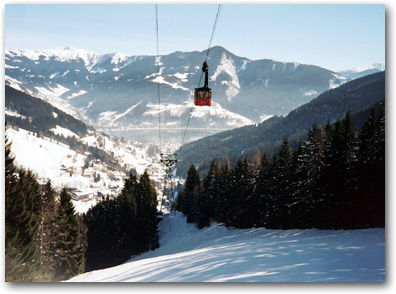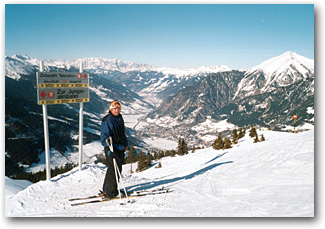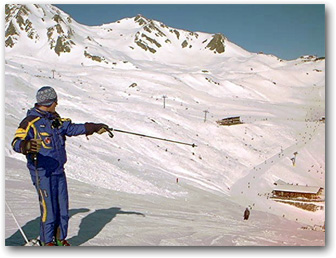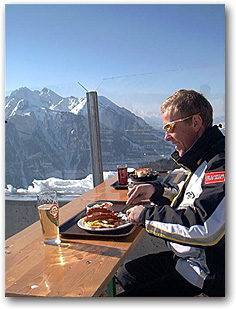

|
|
|
I chose Salzburg. Chronologically closing in on age 50 and after visiting nearly the same number of US ski areas over the past 35 years, I finally committed to my first ski trip to Europe in February 2003. But why Salzburg, or more accurately, why SalzburgerLand, the province of Salzburg, Austria? Renowned for music and castles perhaps, but not exactly at the top of the alpine “to do” list for most American skiers and snowboarders. The answer is an amazing cost-convenience-culture quotient and some great skiing.
On the list of super European deals from my ski trip provider, a package for hotel and airfare to Salzburg was one of the most affordable on offer ($790 when all was said and done). Further, the cost of lift tickets at the best ski areas in the region tallied about 50% less then similarly sized US resorts. Nice value, but there’s also convenience with the superbly managed Salzburg Snow Shuttle, a guide-accompanied, 54 seat motor coach providing daily hotel door to ski lift transportation. Finally, the city of Salzburg redefines the term après ski. The cultural attractions in this world heritage site and home to 150,000 exceed those of many a great metropolis.
As an avid skier though, the cost/convenience/culture thing wasn’t going to amount to a hill of beans in my decision making if the skiing wasn’t good. On paper/web, the five ski areas I planned to visit via the city-run Snow Shuttle looked incredibly good. Though I’d only vaguely heard of a couple before last year, each averaged a vertical drop approaching 4000ft/1200m and a dozen or more high tech lifts, including gondolas, cable cars, and express chairs.
I found the leap of faith worth taking and thoroughly enjoyed exploring an area largely untapped by American skiers and snowboarders. Salzburg is a super gateway for exploring a mother lode of tremendous nearby ski areas, while soaking up the exquisite ambiance each night in one of Europe’s most beautiful, sophisticated, and pedestrian-friendly cities.
I undertook this Austrian adventure with an old friend and traveling companion, Dave Thomson, also a fellow Virginian from the mid-Atlantic region of the United States. Utilizing a mid-February weekend to weekend Super Ski Week package from Ski-Europe, we flew from Washington DC to Frankfurt, Germany and then on to Salzburg, Austria via a short connecting flight.
Despite some touchy weather departing DC and heightened airport security, our flights went smoothly and without major delay. The Salzburg airport is an easy 5 miles from town. We arrived on Sunday afternoon in time to take a walking tour of the city, gaining local knowledge on the salt trade and the powerful 17th century Prince-Archbishops responsible for much of the current architectural grandeur of Salzburg.
We strolled to the birthplace of Mozart, an attractive yellow townhouse at Getreidegassa #9, and then by his modern legacy, the venues for the world famous classical music festival that draws millions to Salzburg each summer. The imprint of Catholicism on Salzburg is unmistakable. There are over 40 churches within the city including a magnificent 400-year-old Dom/Cathedral in the heart of the old town (Altstadt). There seemed to be an even greater number of konditorei/bakeries. Some manner of “sweets” shop stood on every street corner as we wandered through the labyrinthine medieval shopping district of the Altstadt.
Towering over all, on a hill several hundred feet above the city, loomed Salzburg’s most famous landmark, the Fortress Hohensalzburg. Over a thousand years old, it is one of the largest preserved castles in Europe and contains many historical artifacts, making for a memorable and close off-day excursion for ski weekers.
Wrapped in a blanket of snow, winter Sundays in Salzburg are very quiet and most definitely off-season. I felt like we had the whole city to ourselves. I also felt very safe. In a good year, Americans make up only 5-10% of the tourist trade in Salzburg. Since September 11, 2001 the percentage has declined further.
Our first Sunday would prove to be our coldest day. Temperatures dipped below 20 degrees Fahrenheit/-7 Celsius as night fell. After our walk, the sauna at our hotel, the Astron City/NH (Franz-Josef-Strasse 26), felt sehr gut, especially when I poured water scented with eucalyptus oil on the sauna rocks. My universe became a melting, menthol haze.
I can dispense with much further discussion of the week’s weather with the following: blue skies, no wind, and each day a few degrees warmer then the last; perfect for motoring around the Austrian countryside with someone else behind the wheel while we focused our energies on the task at hand - exploring huge ski areas. By the end of our week the on-slope temperatures exceeded 40 degrees Fahrenheit (+5 Celsius). I’m told the skies of Salzburg can be dreary, but the weather we experienced was more like March in New Mexico.
On Monday we visited Flachau, the home mountain of Olympic champion skier Hermann Maier and at just under 45 minutes, our shortest drive on the roster of Snow Shuttle destinations during the week. By the time we had taken in a few sites and learned the rules of the Snow Shuttle game from our onboard tour guide Bryan Crawford, we were pulling into the parking lot next to a 20ft statue of the Herminator.
In the Alps, where the line between one ski area and the next is blurred, the standard mountain metrics used by Americans become unwieldy. Flachau itself had the feel and possibly rough size of Snowbird, Utah, but it’s part of the Salzburger Sportwelt, which means it’s lift-linked or a short bus ride from a total of 215miles/350kms of ski runs, nearly 100 lifts, and dozens of mountain faces with vertical drops in the 3000-4000ft/900-1200m range.
The view from the Flachau parking lot belied this enormous potential. Far beyond the first ridge and known to us only by what we had seen on trail maps was a skiable domain that would dwarf all but a handful of North American resorts. When we met Florian Schwartzenbacher, our guide, instructor and friend for the day from the Sport Am Jet Ski and Snowboard School, I asked him in the spirit of American conspicuous consumption if we could ski to the village of Alpendorf and back, about 10 lateral miles each way. He agreed, but as the day unfolded we would see that it was an overly ambitious goal for two slow moving, picture taking mid-Atlantic skiers.

|
|
|
Early in my day at Flachau I shared a t-bar with an older, 60ish gentlemen from Holland. Like most of the Europeans I would meet during the week, he was very amiable and spoke more than adequate conversational English. I asked him why he chose to ski at Flachau? He had two main reasons, affordability and medical. He had a heart condition and his doctor permitted him to continue skiing as long as he remained below 6560ft/2000m. From his experience, Flachau was one of the most attractive areas fitting that prescription.
I found a nice comfort factor all week as well. The areas we visited fell in the 3000ft/900m to 7500ft/2300m elevation range, relatively low base and summit figures for the Alps (feet to meter conversions throughout this article are approximate). The lower half of the mountains looked much like North American ski slopes with forests of evergreens or hardwoods lining wide groomed runs. Every area also had upper terrain, some of it big, some of it huge, with wide open treeless bowls, often defined only by occasional rock outcroppings or big mogul fields. It was fun to move between the earth and the moon in a single ski day. By the first afternoon I had already overused the superlative Wunderbar.
Our on-snow journey from Flachau to Alpendorf would include a five minute bus connection to the neighboring resort of Wagrain (Vah-grine). The actual ski terrain in this area reminded me of the Wasatch Mountains in Utah, but the near and far mountain backdrops were more akin to the spectacular jaggedness of the Grand Tetons. The 9,827ft/2996m Dachstein Massif dominates the northern horizon line throughout the Salzburger Sportwelt area.
The lift infrastructure was very modern where ever we turned, not only in Flachau, but throughout SalzburgerLand. Almost all of the high speed quads and six packs had bubble tops, a sort of giant sun visor pulled down in the manner of a footrest for use on cold days. They’re not so common in the US. My companion Dave and I went to pull the bubble top down on a six-pack at Flachau just to see how it worked. You would have thought we were caught in the act of stealing a pair of skis from the ruckus raised by our fellow passengers. We quickly learned it was very bad form in Austria to interfere with the Sun on nice days. Given the blue bird weather we had all week, no further tests were conducted on bubble tops.
Several hours into our skiing and just before the last big descent to Alpendorf, Florian suggested that we turn back to make sure we could make the 4pm Snow Shuttle departure to Salzburg. We agreed, but since it was only around 1pm we stopped for lunch first at the beautiful Bachau Hutte, a rustic mountain restaurant in the area of Gernkogel peak (5860ft/1787m) above Sankt Johann. I had a big plate of Rosti-Tiroler, a sort of alpine roast beef hash with a fried egg on top; very hearty stuff and guaranteed to keep your caloric intake up to sporting levels.
After lunch things went from inspiring to perspiring. We came across a few unexpected lift lines (they were generally moderate all week) on the long way back to Flachau. Florian encouraged us to pick up the pace. Suddenly, our picture taking and lollygagging turned into a series of fast paced runs with big vertical descents.
The last major lift ride out of Wagrain back to the slopes of Flachau was on the nearly two mile long, 12 passenger Flying Mozart gondola (3100ft/949m vertical) where I engaged in conversation with a man next to me from Belgium. When he learned where I was from he began to tease me in excellent English about why so few Americans spoke foreign languages, not even snippets of foreign languages. At that point I laid a couple of “German for tourists” phrases on him and relayed that my wife was of Belgian descent with the family name Van Hoomissen. He warmed up nicely and by the time I offered an auf Wiedersehen exiting the gondola, he called out in final good humor, “say hello to George Bush from Hugo of Belgium.”
Our last big plunge of the day, approximately 2500 vertical feet paralleling the Achter Jet gondola, was a serious piece of bobbing and weaving through homeward bound crowds on very hard packed snow. Only when they all tried to depart at once did I realize how many people were sharing the expansive ski terrain with us.
We managed to make it back to our bus a harmless five minutes overdue, but we learned a valuable lesson for the rest of the week. In these mountains we were going to need to practice some better time management skills because the distances, verticals and scope of terrain were far, far greater than the yo-yo type skiing customary to the mid-Atlantic US.
Tuesday’s trip to the Gastein Valley took about 80 minutes, one of the longer jaunts by the Salzburg Snow Shuttle and the only day during our week when the passenger complement on the bus nearly reached capacity. Early in the trip we passed by some of the same sights as the day before, the rocky Untersberg Peak rising dramatically from a level plain just outside Salzburg and further south, the Castle Werfen, locale for the old Clint Eastwood war movie, “Where Eagles Dare”. (Need I mention that two other Hollywood classics were set in the Salzburg area, “The Sound of Music” and “Amadeus”?)
The Gastein Valley contains four multifaceted ski areas in the following order as one enters the valley: Dorfgastein, Bad Hofgastein, Bad Gastein, and Sportgastein, each with a vertical drop no less than 3500ft/1050m. Dorf means little, hof means before, and bad means spa, (after the famed local thermal waters). There’s a lot of skiing and bathing going on in this valley. Our destination, Bad Hofgastein, is lift linked to Bad Gastein, comprising the largest single ski domain in the valley. The others are separate and significant areas accessed locally by car, bus or train.
Shortly after we pulled into the parking lot below the Bad Hofgastein funicular/incline train (1500ft/459m vertical) we were joined by Kurt Fuchs, the young co-owner of the SchneeSport School of Gastein. For a couple of neophytes on a huge, unfamiliar mountain nothing can top the benefit of a master ski instructor to lead the way around his home turf.

|
|
|
From Angertal we boarded the much less busy Kaserebenbahn gondola (2650ft/809m vertical) to quickly access the immense open terrain of the Schlossalm (castle meadow) area. A mile or more wide, criss-crossed by high speed chairs, surface lifts and the Kleine Scharte cable car (100 passengers, 2450ft/747m vertical), we played in the intermediate paradise of Schlossalm for several hours.
At one point we reached lift served terrain as high as 7550ft/2300m where we glimpsed down the start of Hohe Scharte, a five mile/8km advanced trail descending a vertical of 4788ft/1460m all the way back to the funicular base in Bad Hofgastein. Kurt recommended we skip this run and stay high to avoid crowds and enjoy the guten schnee. Though I was severely tempted by the awesome size of the descent, today I decided to let the guide dictate our agenda, not a neophyte from the mid-Atlantic.
Eventually we left the magnificent Schlossalm area and ate a lunch of liver dumpling soup back at Angertal. When Kurt found out we had been in Austria for two full days without yet trying apple strudel, he moved quickly to rectify the problem. My friend Dave tried to show some dietary restraint, but when I told him it came mit schlag (with whipped cream) his will broke and he indulged with me.
Soon, a little heavier in the saddle, we were riding a pair of high speed quads to Jungeralm, another huge open area, this time on the backside of the Stubnerkogel, the snow topped volcano-like mountain rising above Bad Gastein. I mentioned to Kurt that it looked like Stubnerkogel mit schlag.
We stayed on piste for the most part on this trip, but in Jungeralm I found it very easy to veer off the groomed trails to adjacent open areas and enjoy some loosely cut powder, still dry at 7000ft/2150m and relatively light, though a week old. At other places lower down, off piste could mean Sierra cement or thin cover.
Before our last run of the day we walked five minutes to the summit of Stubnerkogel (7370ft/2246m) for a stupendous view north down the Gastein Valley. The walk atop Stubnerkogel was the only time during my week skiing in SalzburgerLand that I felt shortness of breath or noticeable effects from high elevation. I think this is significant coming from someone who has experienced mild altitude sickness while on vacation at several western US ski resorts. The incredible skiing we accessed during our week using the Salzburg Snow Shuttle requires virtually no altitude adjustment for those from sea level localities.
After a pause for picture taking on Stubnerkogel and an extra few deep breaths, we took a final monster red (intermediate-advanced) run dropping 3500ft/1071m from the summit back to Angertal and our shuttle to Salzburg.
“Another day at the office” I quipped to the courteous gentleman from Finland who with his family shared the back few seats of the Snow Shuttle with Dave and I for much of the week. On Wednesday morning we took the 75 minute drive to Zell am See passing briefly through Germany in transit. This was one of the few areas on our itinerary that I had heard of before last year. Zell is set on a beautiful lake (see) at an elevation of about 2500ft/800m and is also a very popular summer resort.
Here we met Christian Pfeffer of the Zell am See-Kaprun tourist office. Before we knew it Christian had us climbing over 3300ft/1000m on a string of lifts including the Zeller gondola and an express chairlift to Panorama Pfiff, elevation 6230ft/1900m. After the quick lift rides we began our first real run down the mountain on a mellow looking intermediate trail called The Schutt. It got a little tougher as it went on and by the time we made it to the bottom of the trail at Zell’s neighboring village of Schuttdorf I think I needed to shave again. We had traveled nearly five miles down a vertical drop of 4000ft/1200m, undoubtedly the most thorough “warm-up” run of my life.
From lake level we rode the three part Areitbahn gondola system right back up to Panorama Pfiff again. This time we took the scenic and very manageable groomed black piste #14 down the center of the mountain to Zell’s signature Schmittenhohebahn 50 passenger cable car.
I can’t resist telling you that I was favorably “schmitten” with Zell am See. It was certainly living up to its reputation for gorgeous, sun drenched, south facing ski terrain. The temperatures actually rose as we rode the cable car to the highest point on the mountain, Schmittenhohe Peak (6560ft/2000m). Apparently, this temperature phenomenon was common here and had something to do with a lake-induced inversion according to Christian.
After a couple of runs near the top of the mountain it was time for lunch. Amidst the barrage of info provided on the Salzburg Snow Shuttle that morning, Bryan Crawford gave us a tip to try the Pinzgauer Hutte for a good lunch and a novel transfer back to the slopes. We had to ski and pole for about a half mile down a gradual trail away from all ski slopes to get there, but it was worth it.
The crystal clear view from the Pinzgauer Hutte was worth the trip to Europe alone. Across the valley, filling up the sky was the huge Kitzsteinhorn glacier with lift served terrain up to 9935ft/3029m. Near the town of Kaprun, this incredible year-round, high altitude skiing and snowboarding option (vertical drop 3500ft/1050m) is where locals like Christian go on their off days because, “the snow is always good there.” The combined Zell/Kaprun area markets itself as the Europa Sportregion.

|
|
|
I told Christian that America could never be the same after September 11, 2001. He agreed it was a terrible thing and mentioned another horrible day in November 2000 when the funicular train bringing skiers to the Kitzsteinhorn glacier inexplicably broke down in a tunnel during the ascent and caught fire. The death toll was 155, the worst accident in alpine ski history. It has since been completely replaced by a state-of-the-art gondola system. After exchanging near miss stories, he on the funicular train, me at the Pentagon, it was clear that many parallels could be found in the trauma inflicted by the separate disasters a world apart. People of either region will never forget the day, the time, and the place.
After our meal with the million dollar view it was time for the transfer back to the ski slopes. The proprietor used a snowmobile to tow 10 of us at a time, water-ski style at speeds approaching 30 mph, back up the half mile distance to the main ski area. From there we had time for a little play near the summit and then took another beautiful, groomed black piste (#13) to a run-out leading back to Zell am See and our awaiting motor coach to Salzburg.
Husband, father and retired civilian employee of the Department of Navy, Jim Kenney is a D.C. area native and has been skiing recreationally since 1967. Jim's ski reporting garnered the 2009 West Virginia Division of Tourism's Stars of the Industry Award for Best Web/Internet/E-Magazine Article.